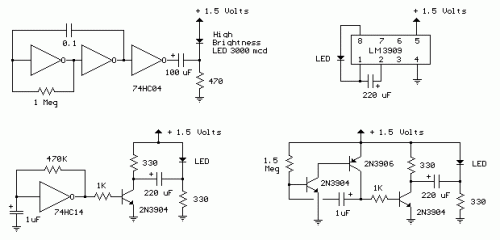- Dancing LEDs Circuit Diagram
- Dark Activated Led or Lamp Flasher
- Two Flashing LEDs Circuit Schematic
- Dicing With LED's
- Bicycle Back Safety Light Circuit Schematic
- AC 220 Volts Flashing Lamps Circuit
- Smooth Flasher Circuit Diagram
- Portable Lamp Flasher
- One Of Nine Sequencer
- Led or Lamp Flasher Circuit
- LED or Lamp Pulsar Circuit
- High-intensity LED Warning Flasher
- Flashing Eyes
- Fading Leds Circuit Diagram
- 12 Stage Neon Sequencer (NE-2 / NE-51)
1.5 Volt LED Flashers
Description
The LED flasher circuits below operate on a single 1.5 volt battery. The circuit on the upper right uses the popular LM3909 LED flasher IC and requires only a timing capacitor and LED.
The top left circuit, designed by Andre De-Guerin illustrates using a 100uF capacitor to double the battery voltage to obtain 3 volts for the LED. Two sections of a 74HC04 hex inverter are used as a squarewave oscillator that establishes the flash rate while a third section is used as a buffer that charges the capacitor in series with a 470 ohm resistor while the buffer output is at +1.5 volts. When the buffer output switches to ground (zero volts) the charged capacitor is placed in series with the LED and the battery which supplies enough voltage to illuminate the LED. The LED current is approximately 3 mA, so a high brightness LED is recommended.
In the other two circuits, the same voltage doubling principle is used with the addition of a transistor to allow the capacitor to discharge faster and supply a greater current (about 40 mA peak). A larger capacitor (1000uF) in series with a 33 ohm resistor would increase the flash duration to about 50mS. The discrete 3 transistor circuit at the lower right would need a resistor (about 5K) in series with the 1uF capacitor to widen the pulse width.
